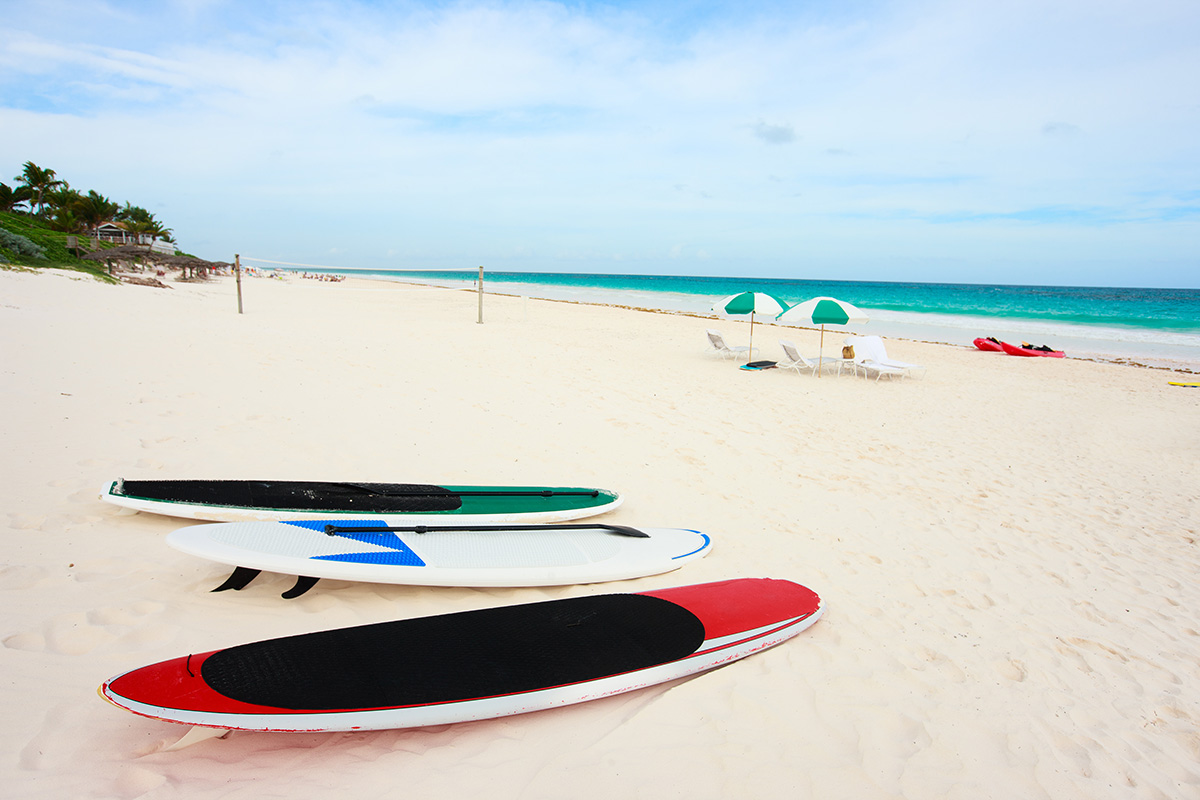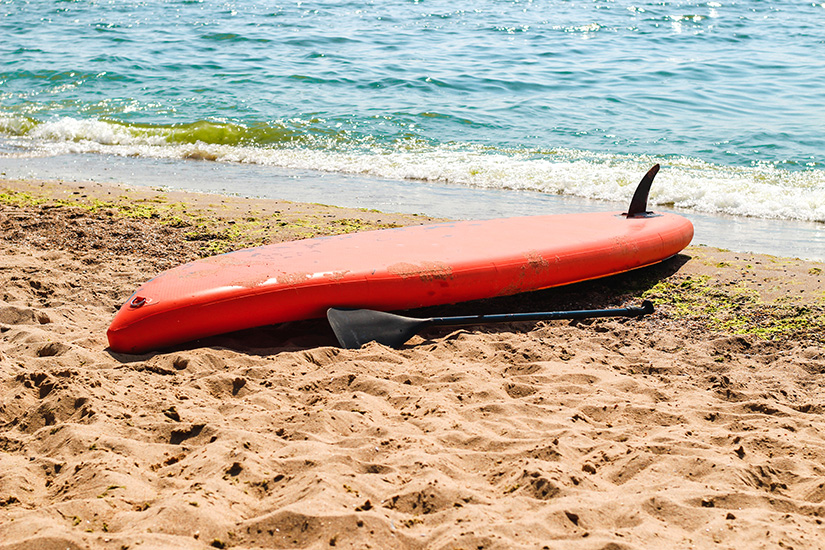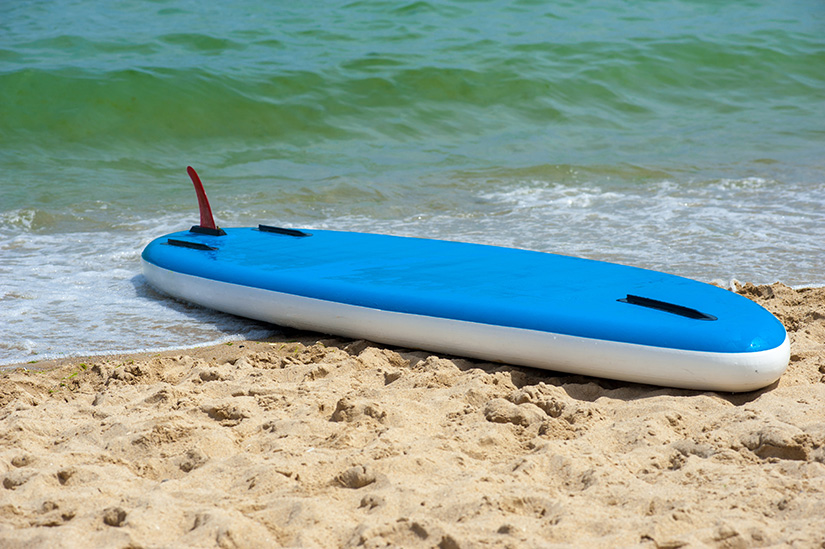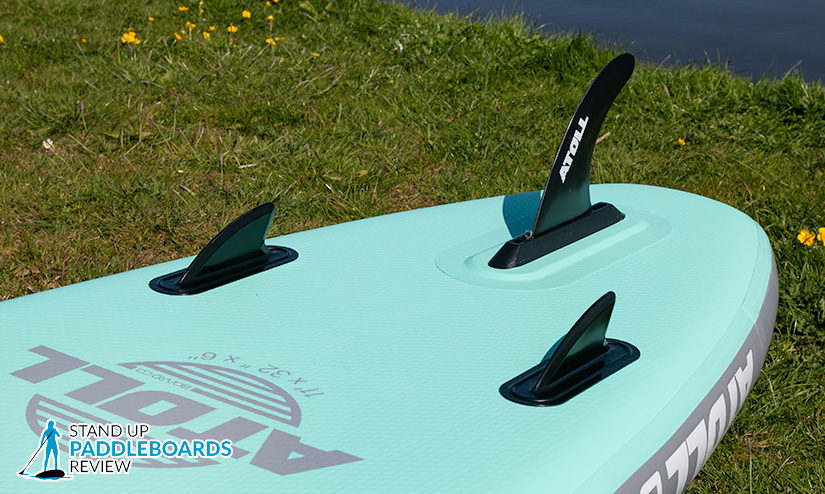An amazing paddle boarding experience starts with having the right paddle board. This means taking into account every detail–including the fin setup.
Fins on a paddle board may be small but they have an important role. Without a fin, you would have a hard time controlling your SUP board and making it go straight. That said, paddle boards come with different fin setups. The single-fin and the three-fin setup are the most common.
When deciding between a 1-fin vs 3-fin paddle board there are a few things you have to consider. For instance, how and where do you intend to use the paddle board? A single-fin paddle board would be best suited for touring and racing. A three-fin SUP, on the other hand, is best for surfing and whitewater paddling.
Let’s dive deeper into the details.
How Fins Affect Paddle Board Performance
Fins help with tracking, that is, they enable a paddle board to travel in a straight line. Without a fin, the tail of your SUP board will be slipping sideways when you paddle, causing the rest of the board to zigzag. It will be challenging trying to follow a straight path to your destination. This can be frustrating.
Paddle board fins also help with stability and maneuverability, especially when turning or paddling choppy waters.
SUP fins come in different shapes and sizes–factors that also affect how the fin influences performance. A larger fin, for instance, offers great tracking but it’s not the best for maneuverability.
One-Fin Vs Three-Fin Paddle Board
Paddle boards come with different fin configurations. If a SUP board has only one large center fin, then that’s a single-fin setup. If it has the center fin and two smaller side fins, that’s the three-fin setup. Other paddle boards may have two or four fins but that’s not very common.
When deciding between one fin and three fins, it’s important to know the pros and cons of these two setups.
Benefits of 1-Fin Paddle Boards
The one-fin setup facilitates speed and tracking. Any object attached to your paddle board will create resistance when moving through the water, and a fin is no different.
But having only one fin as opposed to three means less resistance. So you’ll be able to paddle faster with minimal drag.
This setup works best for paddle board racing and touring as well as flatwater paddling.
In many cases, you can change the fin placement of your center fin by sliding it towards the front or back. This adds some versatility as it changes how the SUP fin affects your paddle board’s performance.
Sliding it forward enhances maneuverability, making the paddle board easier to handle. This is ideal when paddle board surfing. However, it will negatively impact speed and tracking.
Sliding it back will make the paddle board travel faster and track straighter.
Drawbacks of 1-Fin Paddle Boards
The single-fin system is not as versatile as the three-fin setup. A paddle board with this setup only comes with one slot for the large center fin. You can’t add or remove fins to try other fin setups.
However, some have a universal fin box that will allow you to try different fin sizes and designs. But that’s all–you’ll always just have one fin.
Benefits of 3-Fin Paddle Boards
The three-fin setup is also sometimes referred to as the thruster fin setup. It usually has three fins, one at the center and two on either side. All fins are about the same size.
There’s also what’s called a 2+1 fin setup which includes three fins. But in this case, there is a larger center fin and two smaller side fins. It is a common setup as well.
The three-fin configuration enhances stability and maneuverability. The paddle board will perform well in surf and whitewater because it is more stable and easier to turn.
The best thing about this system is its versatility because many boards now come with removable fins. You will be able to switch to a single-fin system or even just two fins, depending on where you’re paddling.
Drawbacks of 3-Fin Paddle Boards
Having three fins means more resistance and this will definitely impact speed. A paddle board with the three-fin setup will have more drag and won’t glide as fast as one with a single-fin setup.
Which Fin Setup Is Right for You?
The answer to this question depends on how you intend to use your paddle board.
For instance, you want versatility for all-around paddle boarding so a SUP board with three removable fins would be the best option. You can switch from one setup to another to suit the paddling conditions.
A non-removable three-fin setup would work well for surfing and whitewater because these situations call for high maneuverability and stability.
If you expect to be doing a lot of long-distance touring and racing, your priority should be speed and tracking. This means that a single-fin setup would be more suited.
Please note that the fin setup is just one aspect of what matters when choosing a paddle board.
Frequently Asked Questions
Does the Fin Make a Difference on a Paddle Board?
Yes, fins make a difference on a paddle board. If you try to paddle board with no fin, you’ll have a hard time making your paddle board go straight. You may have to switch paddling sides more often than you need to and it can be quite tiring and frustrating.
Is a Short Fin Better Than a Long Fin on a Paddle Board?
This will depend on where you are paddle boarding. Longer fins will offer better tracking but less maneuverability. It would, thus, be ideal for touring, racing, and flatwater paddling. However, you risk running aground when paddling in shallow water. So keep that in mind.
A short fin offers excellent maneuverability but won’t track as well as a longer one.
How Many Fins Should I Have on My Board?
The number of fins you should have on your board will depend on your paddling style. If you will be mainly paddle board surfing or whitewater paddling, your priority should be maneuverability and stability. So in this case, you should opt for three fins.
For long-distance paddling and speed, a single fin is best.
How Do I Choose a Paddle Board Fin?
Paddle boards come with fins already installed, and some brands even include extra fins so you can change the setup if needed.
But if you’re looking for aftermarket fins, you first need to find a fin that is compatible with your fin box. You should also consider where you intend to paddle and the material used to make the fins. They are usually made using different materials including plastic, carbon, and fiberglass.
Plastic fins are the cheapest while carbon fins are the most expensive and have the best performance.
Can You Use a Paddle Board Without the Middle Fin?
Yes, you can remove the middle fin and only use the side fins. But this is not ideal and you may find that the SUP is harder to keep on course, especially when flatwater paddling.
Conclusion
Both one-fin and three-fin paddle boards have their pros and cons.
A single-fin paddle board has less resistance and will track better with great speed. It is ideal for calm water paddling, long-distance touring, and racing. A three-fin paddle board has more stability and higher maneuverability. It is suitable for whitewater paddling and surfing.
Other than the fin setup, the size of the fins and fin placement also affect performance. For example, if you have a single fin and slide it towards the nose, you improve maneuverability. If you slide it back towards the tail, you improve tracking.
If you’re torn and don’t know which setup to choose, consider a three-fin setup with removable fins. It will allow you to experiment with different configurations.




